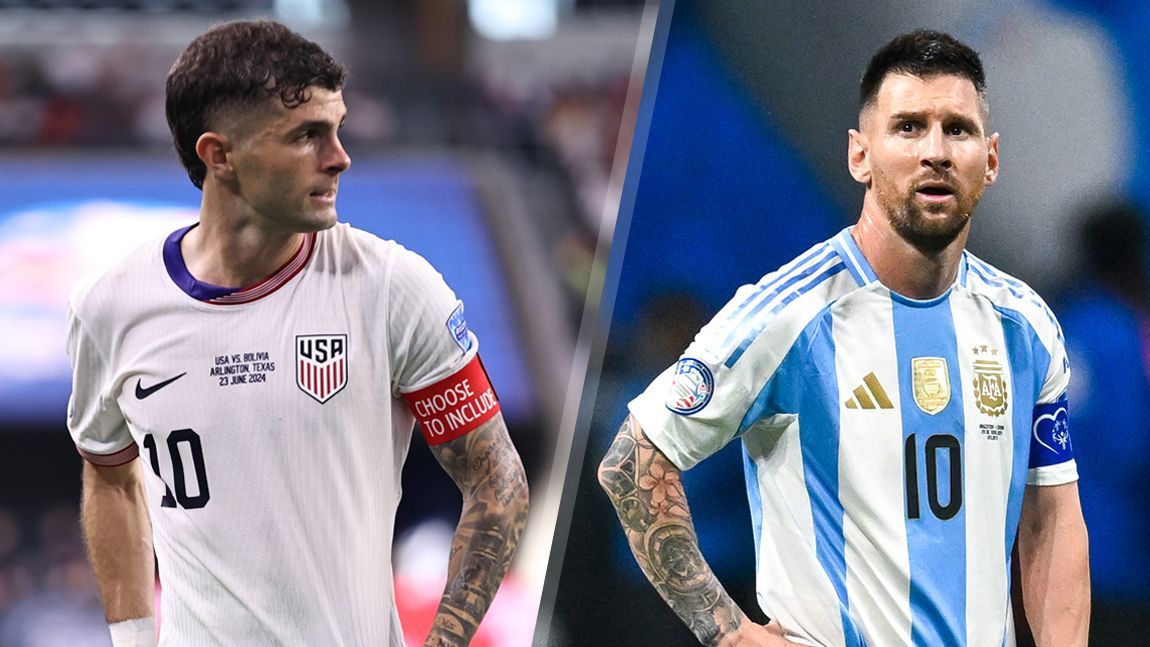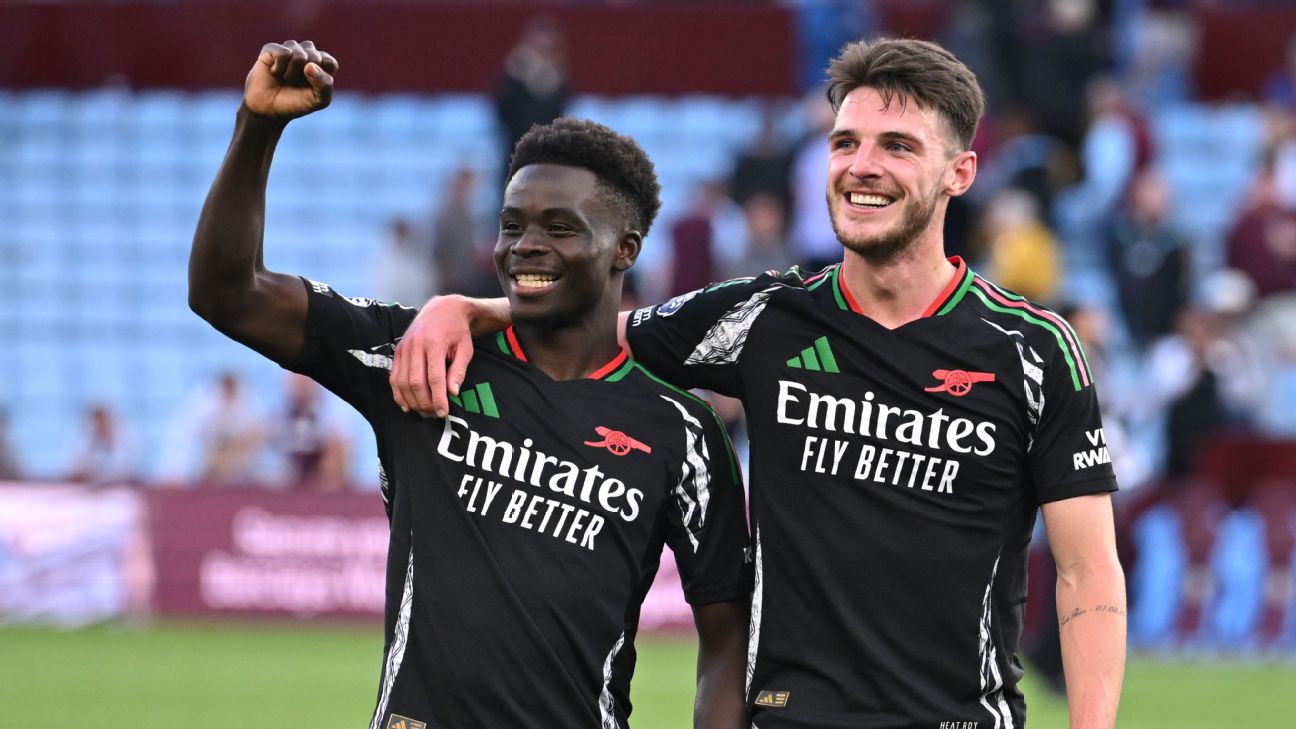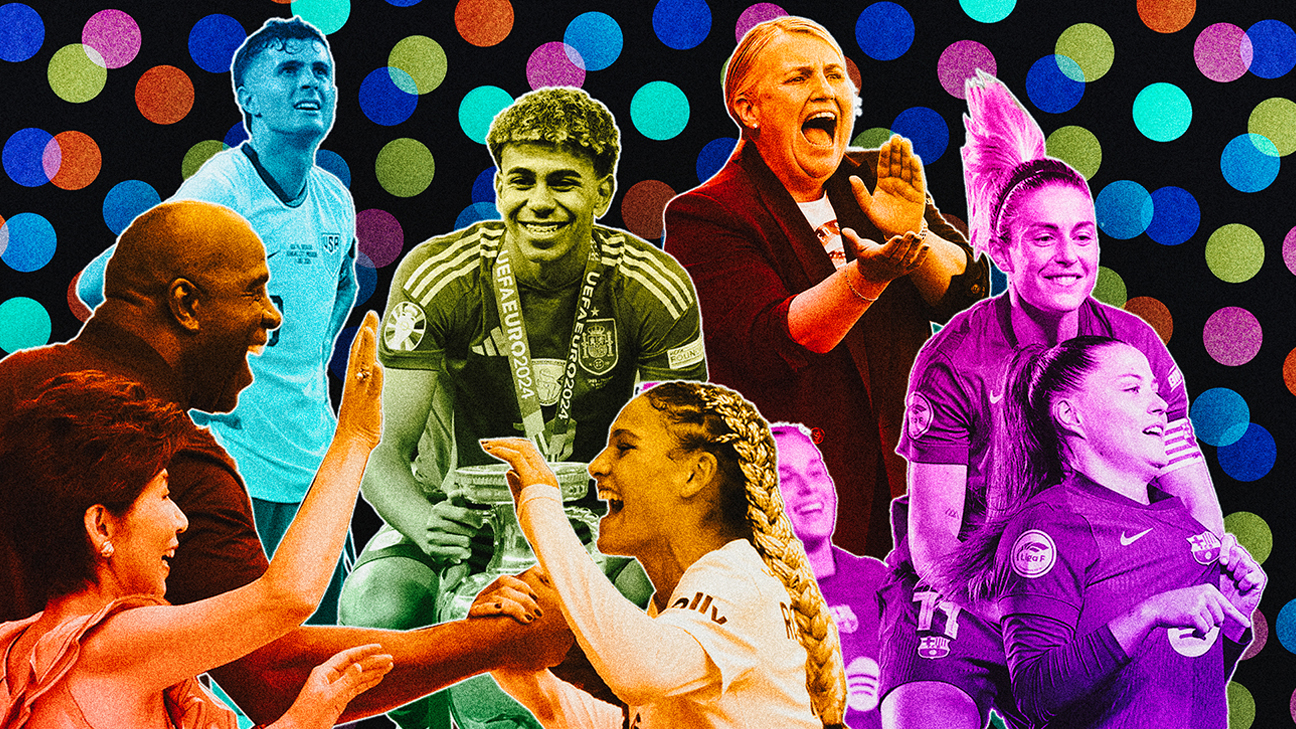Omar Vega/Rich von Biberstein/Getty Images
If the Copa América goes as expected, Argentina will reach the tournament final on July 14 in Miami Gardens, Florida, with the chance to lift another trophy. Argentina, after all, are the defending Copa América champs and the defending World Cup champs. Before the tournament kicked off, the betting markets gave them a greater than 50% chance of reaching the final.
If everything goes according to plan for the U.S. men’s national team, they’ll be the ones facing Argentina on July 14. But for the USMNT, a run to the final is not the expectation — it would be a dream best-case scenario and the USMNT’s best performance in a major tournament ever. Even with a 2-0 win in the opening match against Bolívia, the U.S. only has about a 15% shot at making it to the final, per ESPN BET — up from 12% before the tournament started.
Plenty of teams are capable of making an underdog run in a knockout tournament — the already-random nature of soccer gets ratcheted up when it becomes a win-and-you’re-in. Peru reached the Copa América final in 2019 and Paraguay did it in 2011. Greece won the Euros in 2004, and Croatia made the final of the 2018 World Cup. None of these were the expected conclusions. The likes of Morocco, Denmark and Wales have all made the semifinals of major competitions in recent years, too.
But the ultimate goal for the USMNT — in a country this wealthy, with this many potential professional soccer players — isn’t to just be good enough to make one memorable run. No, it’s to get to the level of Argentina, where you expect to make a deep run in every single tournament.
How long, then, might it take for the Americans to get as good as Lionel Messi & Co. are right now? How big is the quality gap between the U.S. and Argentina, really? As Copa América continues, now is as good a time as any to dig in.
OK … how big is the gap between the USMNT and Argentina?
From a pure results perspective: pretty freaking big.
Per the Elo ratings, Argentina are the best team in the world, while the USMNT ranks 22nd. A better way to measure the gap, though, is to look at the actual rating of both sides. Elo awards or subtracts points from a team based on the result of the match, the scoreline, the quality of the opponent, the location of the game and the competitiveness of the match. For reference: Argentina lost 52 points in the defeat to Saudi Arabia at the World Cup, while the U.S. gained 13 points in their draw with England.
Before the tournament, Argentina’s rating was 2,144, while the Americans sat down at 1,790. The gap between the two teams is basically the same size as the gap between the U.S. and 96th-rated Martinique. The last time the U.S. played Martinique was at the 2021 Gold Cup, and the Americans won 6-1 with their B-team:
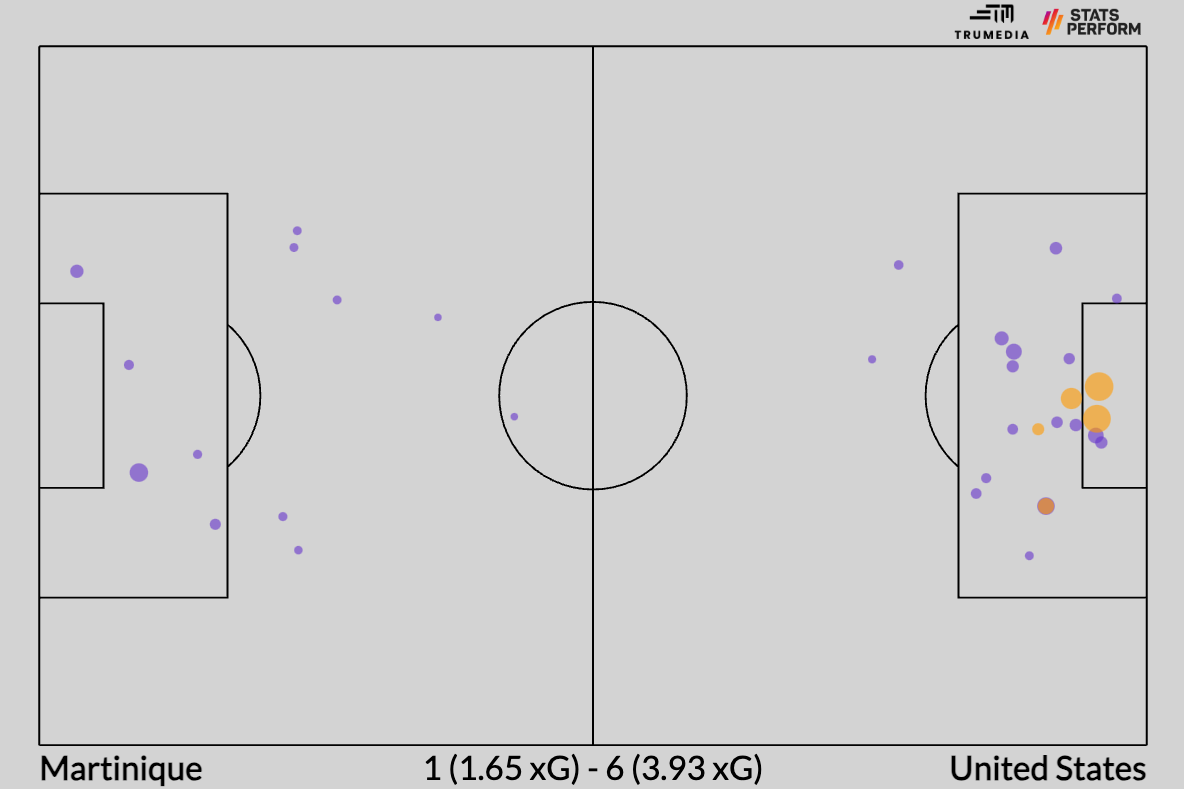
Funnily enough, the gap in quality we saw in that match — as measured by the expected goals created by both teams — was roughly equivalent to the gap we saw between the U.S. and Argentina the last time they played: the semifinals of the 2016 Copa América. (Expected goals, or xG, is a measure of chance creation and how dangerous a team is offensively. Given the random, low-scoring nature of soccer, it’s the best measure we have of how well a team is playing.)
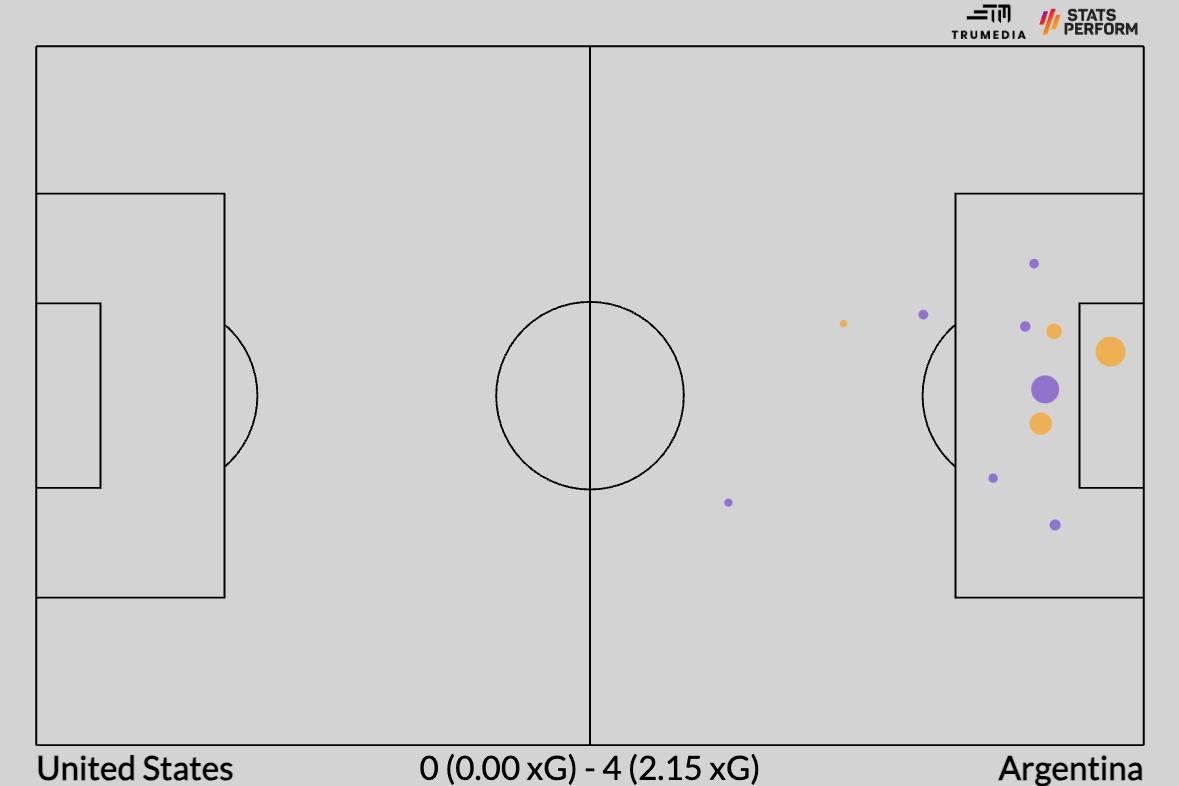
By design, Elo is a conservative, slow-moving rating system that accounts for a long history of matches. Another way to look at the difference between the two sides would be to try to measure the pure talent produced by both countries. These talent shifts can be sudden, in both directions — a player ages out of his prime, a prospect develops into a star, a star makes a one-time switch to represent a different country — and most rating systems won’t account for those changes right away.
The soccer consultancy Twenty First Group maintains a player rating system that assesses players by how much playing time they get, how good the team they’re playing for is and how much they contribute to defense and attack. If you take the average rating of a country’s 25 best players, England are, unsurprisingly, the highest-rated team in the world. The Premier League has six of the 10 richest clubs in the world, and many of those players are English, after all. Brazil rank second. Brazilians played 148,940 minutes across Europe’s Big Five leagues last season — the highest mark for a country that doesn’t host one of the Big Five leagues.
Argentina, meanwhile, sit ninth in the rankings, below the Netherlands and above Belgium. They’re not as deep as the likes of Brazil, England and France, and things like “Lionel Messi playing in MLS” probably unfairly penalize them in the model.
As for the U.S.? They’re 30th — one spot below Russia and one above Senegal. That lines up almost exactly with the 26 Americans who appeared in one of Europe’s Big Five leagues last season — the 29th-most players of any country.
Why Argentina are so good
Let’s sketch out what Argentina’s squad actually looks like.
To start, how many “stars” do they have? To define “star,” we’ll just use ESPN’s FC 100. What Argentine players did a group of soccer journalists collectively rate as some of the 100 best players in the world?
In goal, Aston Villa’s Emiliano Martínez was ranked second overall. In defense, there were zero Argentines. In the midfield, Chelsea’s Enzo Fernández ranked 27th and Liverpool’s Alexis Mac Allister came in at 17th. And among forwards, we had Roma’s Paulo Dybala at 24th, Inter Milan’s Lautaro Martínez at 12th and some guy called “Lionel Messi” at seventh.
That distribution tracks pretty well with how Argentina play: They try to be impossible to break down off the ball, but they’re also comfortable with Martinez facing shots because he’s so good. You can’t score on them, and then you probably can’t stop the midfielders and attackers combining with Messi to create enough goals to win.
Funnily enough, Dybala hasn’t played a minute in World Cup qualifying and didn’t make the Copa América roster, while Martinez still hasn’t become a consistent starter for Argentina. But since we’re trying to account for the overall talent of a country, we’ll still slot both of them in as stars. That makes six stars for Argentina.
Then we can divide the rest of the Copa América roster into a couple of other subcategories:
Starters for elite teams: Julián Álvarez started 31 games for Manchester City in the Premier League this season. He should probably be on the “star” list, but we’ll call it a wash with him and Dybala.
Former starters for elite teams: Ángel Di María and Nicolás Otamendi play for Benfica now, but they were both contributors at the absolute highest level of the sport for a long time. We’ll toss Leandro Paredes in here as well — he did start the 2020 Champions League final for PSG.
Champions League-level players: Manchester United stink, but Lisandro Martínez is very good (when healthy). Cristian Romero has been a starter for both Atalanta and Tottenham in the Champions League. Exequiel Palacios is a starter for Bayer Leverkusen, and let’s add Manchester United’s Alejandro Garnacho into this category, too. Then there’s the Atletico Madrid duo of Rodrigo de Paul and Nahuel Molina.
Big Five league contributors: Here, we’ve got Fiorentina’s Nicolas Gonzalez and Lucas Martínez Quarta, Real Betis’ Guido Rodríguez and Germán Pezzella, Tottenham’s Giovani Lo Celso, Nottingham Forest’s Gonzalo Montiel, Lyon’s Nicolás Tagliafico, Monza’s Valentin Carboni, Ajax’s Gerónimo Rulli and Sevilla’s Marcos Acuña.
Other: The lone non-Europe-based player, non-Messi division: 37-year-old River Plate keeper Franco Armani.
Argentina’s Copa América squad looks something like this:
• Stars: 6
• Veteran former stars: 3
• Champions League-quality players: 6
• Big Five-quality players: 10
• Domestic players: 1
Their Copa roster only features five players who weren’t part of the 2022 World Cup-winning team.
Why the USMNT isn’t as good as Argentina
Let’s apply the same distinctions to the USMNT’s roster.
Stars: Christian Pulisic was the only American to make the FC 100, coming in at 28th among all forwards, one spot above Manchester City’s Jack Grealish and one below PSG’s Ousmane Dembélé.
Veteran former stars: None.
Champions League-quality players: We’ll be generous here and include Juventus’ Weston McKennie and Timothy Weah, AC Milan’s Yunus Musah and PSV’s Malik Tillman here. McKennie’s actual production leaves a lot to be desired, but he continues to start for Juventus and could soon be headed to Aston Villa, per the rumor mill. Weah made only 12 starts for Juventus, Musah made only 13 starts for Milan and Tillman made only 17 for PSV. But taking the rosiest view of the current situation serves our purposes.
Big Five league contributors: Monaco’s Folarin Balogun goes here for now, as does Fulham’s Antonee Robinson. Balogun is the most likely player in the pool to one day leap into the star group, while Robinson seems good enough to play in the Champions League.
Bournemouth’s Tyler Adams and Real Betis’ Johnny Cardoso are currently both holding midfielders at this level. Given that Gio Reyna struggled for minutes at Nottingham Forest, who barely survived relegation in the Premier League, he stays here for now. His short-lived teammate, goalkeeper Matt Turner, also stays here, despite losing his starting job at Forest.
Brenden Aaronson sticks around this category for now, although it seems like he might spend this season in the Championship with Leeds. Fulham’s Tim Ream has been here for a long time, and he’s joined by his partner in defense, Crystal Palace’s Chris Richards. We’ll round the section out with Celta Vigo’s Luca de la Torre and Borussia Monchengladbach’s Joe Scally.
Other: PSV’s Ricardo Pepi started only one game this season, so he falls into other-dom. Cameron Carter-Vickers starts for a Champions League team, technically, but unlike PSV, Celtic are never a realistic threat to make it out of the group stages — Celtic being in the Champions League is more due to how teams qualify.
Everyone else: Haji Wright at Coventry, Josh Sargent at Norwich, Ethan Horvath at Cardiff, Mark McKenzie at Genk, Kristoffer Lund at Palermo and the MLS trio of Nashville’s Shaq Moore, Toronto’s Sean Johnson and Cincinnati’s Miles Robinson.
Here’s how the current USMNT shakes out:
• Stars: 1
• Veteran former stars: 0
• Champions League-quality players: 4
• Big Five-quality players: 11
• Domestic and non-Big Five players: 10
Then, compared to Argentina, the U.S. has:
• 5 fewer stars
• 3 fewer veterans
• 2 fewer Champions League players
• 1 more Big Five-quality players
• 9 more domestic-and-other players
The Americans need both better low-end depth and better top-end depth to ever be like Argentina.
That makes sense when you think about it. At the 2014 World Cup, the USMNT’s talent distribution looked something like this:
• Stars: 0
• Former stars: 0
• Champions League-quality players: 0
• Big Five-quality players: 7 (Tim Howard, John Anthony Brooks, Geoff Cameron, Brad Guzan, Alejandro Bedoya, Fabian Johnson and Timmy Chandler)
• Other: 16 (everyone else on the squad played in MLS or outside the Big Five leagues)
Ten years later, there’s basically been a five-player shift. It’s not quite as precise because the 2014 team only had 23 players, compared to the 26 at this summer’s Copa América. But there are five fewer “other guys,” four more Big Five-level players and five more players in the Champions League-or-above categories.
Based on that rate of turnover, the USMNT’s low-end depth could match Argentina’s in, say, 20 years. Would it shock anyone if, come 2044, the USMNT was frequently announcing rosters composed almost totally of professional players in the Premier League, Bundesliga, Serie A, Ligue 1 and LaLiga?
Herculez Gomez believes Christian Pulisic will be key for the USMNT during the Copa America.
From a broad perspective, it makes sense. Training quality is improving for young players in the United States, and a growing number of young players with American ties are going over to Europe at a young age. If more Americans have access to affordable top-level training and training in Europe’s top academies, it should follow that more Americans would develop into players good enough to play for Bournemouth and Bologna.
There’s one problem: development of the highest-end talent doesn’t always follow such a linear pattern, and we can’t be confident that’s how the USMNT’s future will play out.
Take Belgium, for example. At the 2018 World Cup, they had eight players who could conceivably be considered one of the best players in the world at their positions: Thibaut Courtois in goal; Jan Vertonghen, Toby Alderweireld, and Vincent Kompany in defense; Mousa Dembélé and Kevin De Bruyne in the midfield; and Eden Hazard and Romelu Lukaku up top.
Now, at the Euros, six years later, De Bruyne is the only player on the current squad with a real claim as one of the world’s best at his position. The bottom end of the roster is no worse than it was in 2018 — the team is still filled with players in Europe’s top leagues — but the number of Belgium players to make the FC 100 is the same as the number of USMNT players.
Similarly, the development of superstars such as Mohamed Salah in Egypt or Gareth Bale in Wales might lead to a boom in soccer interest, which might lead to more professional players from both of those countries, but it doesn’t mean there will soon be two players as good as either Salah or Bale. It’ll probably be quite a long time until either country produces a single player who’s as good as either one.
There’s some research that, when taken together, suggests developing stars is different from developing pros. One study found that more than 30% of the pros in Europe were born in the first three months of the year, while fewer than 20% were born in October or later. This is because the older kids are bigger at a younger age, so they perform at a higher level early on, get rewarded with better training and placement on better teams and have a massive leg up from the jump. However, another study found that the players who win awards at the highest level — the stars — are more likely to be born at the tail end of their age group than at the beginning.
It seems unlikely the USMNT can engineer superstar production without totally revamping this country’s sports culture and centering it on soccer. There’s a reason why the best teams tend to be the same teams. Every country goes through cycles, but the history of international soccer is basically the history of Argentina, Brazil, Germany, Italy, Spain, France and England — the two richest countries in South America and the five richest countries currently recognized by UEFA. Other countries have been able to break into that tier for a cycle or two, but no one else has retained international relevance at the highest level for as long as those seven nations. They’re the only countries to win the World Cup since 1950.
Plus, this exercise is probably underselling Argentina’s talent because one of their stars — yes, the guy named Messi — is the greatest soccer player of all time. And by our arbitrary star rankings, Germany have 14, France have 13 and England have 12.
Will the U.S. ever get there? Barring some kinds of massive structural dislocations to the arrangement of modern society that make certain sports no longer feasible, probably not. Now, they don’t have to get there, exactly, to compete for major titles. Since 1950, the Netherlands, Sweden and Croatia have all made the World Cup final. A deep squad with five or six stars is enough to legitimately hope to win a major trophy.
The depth almost seems inevitable at this point. Enough Americans play the sport, and the rise of the USL combined with MLS academies means that fewer potential pros are falling through the cracks. The pathways for young Americans to go to Europe have been created. But as the frustrating club careers of Pulisic, Reyna and Adams show, it’s really hard to become a consistent star in a sport that the rest of the world also plays. And while Pulisic made our star list, he just barely qualified for the list.
There are only three MLS players on the USMNT’s Copa América roster. In 15 or 20 years, there might not be any — or maybe the ones that are there will be winding down careers after successful stints in Europe. There will probably be fewer players on Genk and Palermo and more on Aston Villa and Atletico Madrid. But when will those guys be backing up a starting lineup of true stars, rather than being asked to star themselves?
Without that kind of talent, it’s unlikely that the USMNT will face Argentina in the Copa América final on July 14. But even if the unexpected happens and USMNT defies the very long odds, it won’t mean that the U.S. program has reached the level of Messi and Mac Allister and Martinez. And if the USMNT does one day reach Argentina’s level of consistent, expected excellence, none of the players on that theoretical team will remember the 2024 Copa América — because it’s unlikely that any of them have even been born yet.
